Painted Monasteries in Romania: Complete Travel Guide
Some of the links may be affiliate links, and at no cost to you, I earn a small commission if you make a purchase. I only recommend stuff I love and use, and the income goes back into making this little blog successful!
The painted monasteries in Romania are UNESCO World Heritage Sites located in the northwest of my country, in the region of Bucovina. They are from the 1500’s time period (very old), well-preserved, sacred places, where Orthodox religion and nuns wander through their rose gardens, and time as we know it in the capitalist world is arbitrary.
Existential musings aside, my parents and I are Romanian from the region near Brasov, and this past summer, we planned a whole month-long road trip through the country – it was our first time in Bucovina seeing the painted monasteries, and we LOVED them!
➡️ THE HARDEST PART: One of the toughest parts about planning a trip to see the painted monasteries in Romania is figuring out an optimal route. The other tough part is getting to know the monasteries so you can plan which ones you want to visit in the time you have in Bucovina.
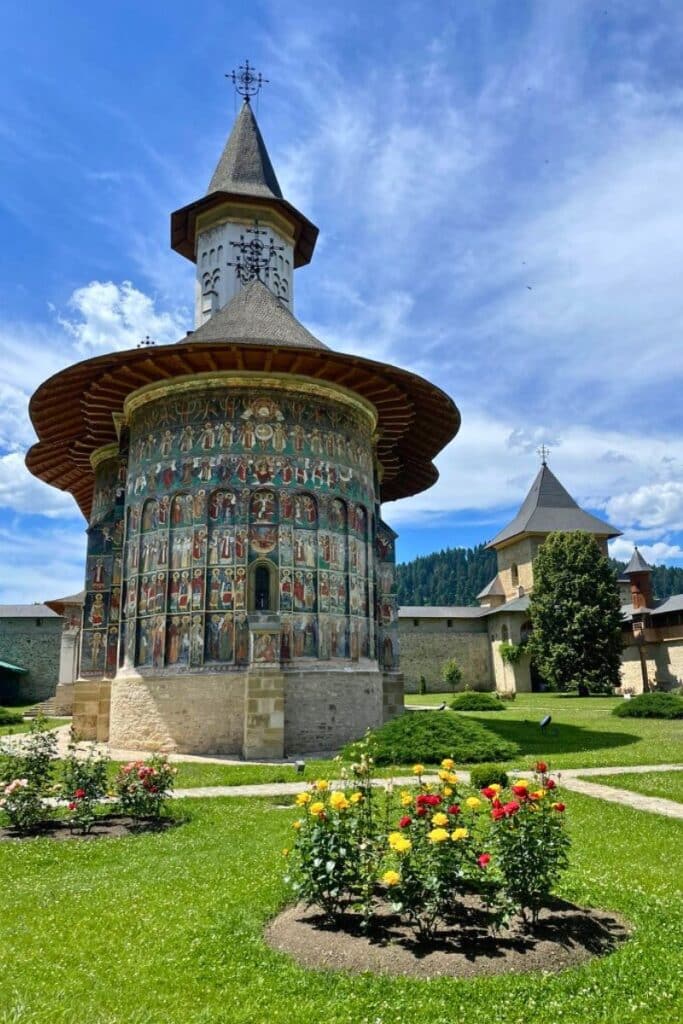
When I started planning, we allotted about 4 days in Bucovina to see the painted monasteries and do some hiking, but we wished we stayed longer.
The natural beauty in the summertime, the Romanian food (a bit different in this region compared to our style in central Romania), and the old-school traditions we experienced in the various villages where we stayed was too good!
In this post, I’m going to share my optimized driving route, where I stayed, and all you need to know about each monastery to choose which you want to visit and which to leave for next time.
Where Are The Painted Monasteries in Romania
The painted monasteries in Romania are mostly located in the Bucovina region, in the far north near the border of Ukraine. The best-preserved ones are in Moldovita, Sucevita, Voronet, Humor, and Putna.
You will need a minimum of 2 days to visit all of the monasteries I went to – simply because of the driving times. And also, you can’t rush it when touring God’s homes on earth.
🚗 DAY 1 ROUTE: Sucevita, Moldovita, and Putna (on the map in red). DRIVING 🚗 DAY 2 ROUTE: Voronet and Humor monasteries (on the map in green).
🏠 WHERE I STAYED: Fundul Moldovei at La Baciu Colacu
I recommend staying where we did, near one of these two more traditional villages: Fundul Molevei or Sadova (on the map in blue). We spent a couple of days at La Baciu Colacu, and it was glorious!
I also recommend taking a bit more time to explore Bucovina a bit more deeply – there’s more to it than Orthodox painted monasteries.
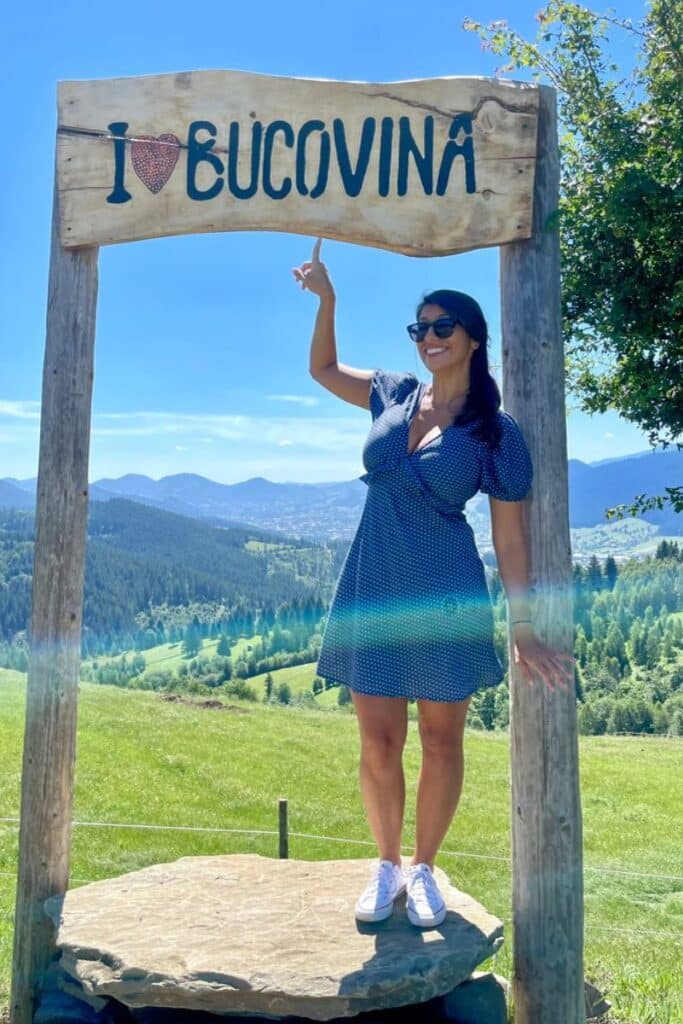
About The Painted Monasteries in Bucovina
Eight of the churches in this northern region of Romania are UNESCO World Heritage sites, and we visited a few of them – basically the ones we thought were most pretty and well preserved.
Here’s what you need to know about each monastery, from a bit of history to the logistics of where it is and how much it costs to get in.
Sucevița Monastery
📍Location: Google Maps
⏰ Opening Hours: 7 a.m. – 9 p.m.
🎟️ Admission: 5 lei ($1.25)
Sucevița is one of my favorite painted monasteries in Romania, partly because it’s one of the best preserved, and because it’s fully run by nuns who take their rose bush gardens seriously.
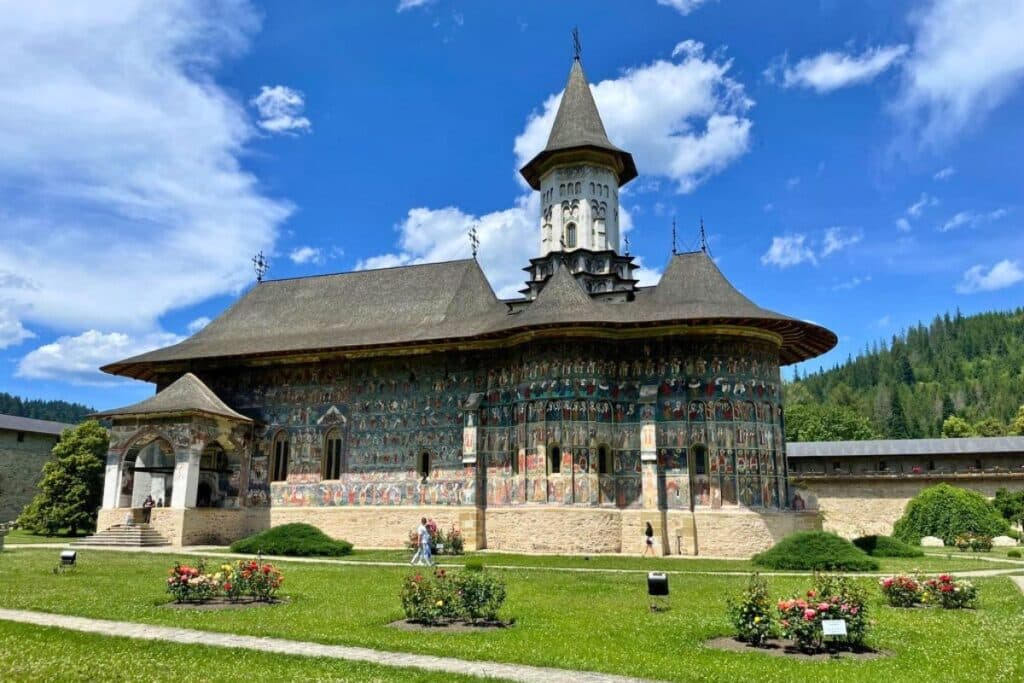
The walls of the monastery are like giant storybooks. They’re covered in colorful paintings showing scenes from the Bible. These pictures were meant to teach people about faith back when most couldn’t read.
An especially famous fresco is the “Ladder of Divine Ascent” about the journey to heaven. Each step represents something good, like kindness, patience, or faith, that helps you on your way.
But here’s the twist—there are also little demons trying to pull people off the ladder! It’s a reminder that staying on the right path can be tough, but with determination and help from above, you can make it. The painting at Sucevița Monastery is one of the most famous versions of this scene!
FUN FACT: We saw quite a few nuns and monks beating a long wooden beam with a mallet, and you might too. My mom told me this was a call to prayer.
The tradition started when the Ottoman Empire was trying to take over the Moldova region a few centuries back, and the Turks outlawed the ringing of bells, which is common in Orthodox churches. Since then, it has become a tradition in this area to call folks to prayer by beating on the wooden beam. It’s called “bate toaca“.
Moldovița Monastery
📍Location: Google Maps
⏰ Opening Hours: 7 a.m. – 9 p.m.
🎟️ Admission: 5 lei ($1.25)
Back in the early 1500s, a Moldavian ruler named Petru Rareș built Moldovița Monastery to protect his people and to show their deep faith in the Orthodox religion. He wanted it to be not just a place of prayer, but also a fortress, so the monastery actually has some pretty thick walls and towers to keep it safe.
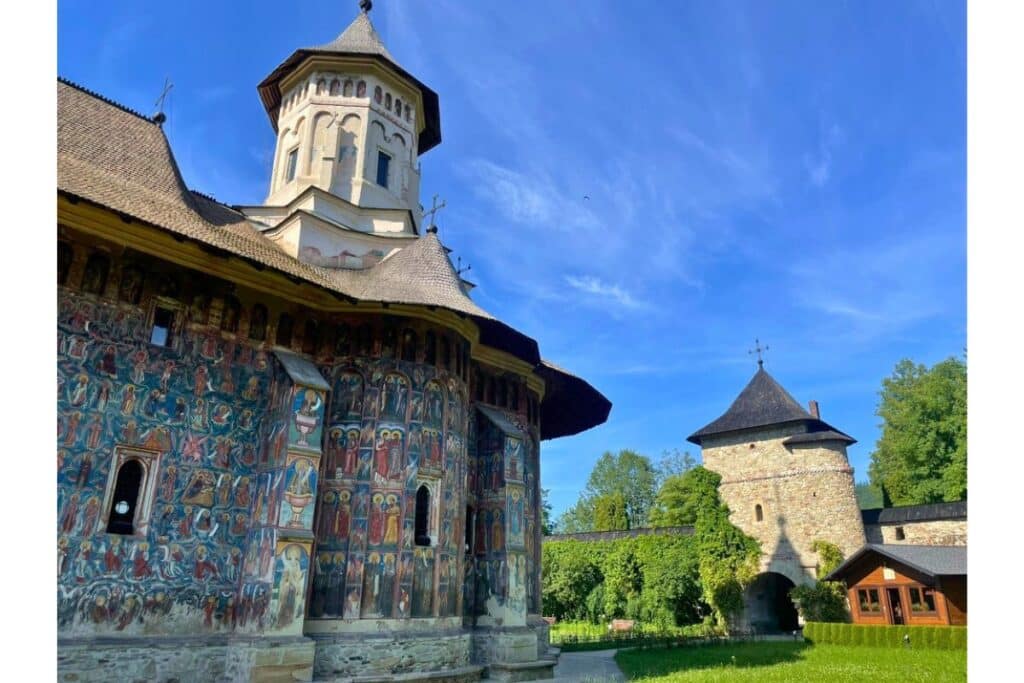
What makes Moldovița so special are the vibrant paintings on its walls. One of the most famous frescoes is the “Siege of Constantinople,” showing a big battle where angels swoop in to save the day – but because this is Romania, the battle is about the Turks trying to take over Moldova region, so the bad guys all wear turbans (like the Turks), and the good guys are the Romanian people.
What I liked most is that Moldovița’s paintings still glow with their original colors, thanks to a special mix of natural pigments used by the artists – this is called the “voronet blue“.
Today, Moldovița, similar to Sucevița, is run by nuns who live there and dedicate their time to their faith. They also greet you at the door and take your admission fee, as well as care for the monastery.
NEARBY ATTRACTION: A cute spot you can also visit near this painted monastery is the “Lucia Condrea” Painted Eggs Museum. It’s open from 9 a.m. – 6 p.m. and admissions are 5 Lei.
Voroneț Monastery
📍Location: Google Maps
⏰ Opening Hours: May – September: ~9 a.m – 8 p.m. | October – April: 9 a.m – 5 p.m.
🎟️ Admission: 5 lei ($1.25)
My parents were the most excited to visit the Voroneț Monastery because I think it’s often called the “Sistine Chapel of the East.” A bit much, but hey – when in Romania!
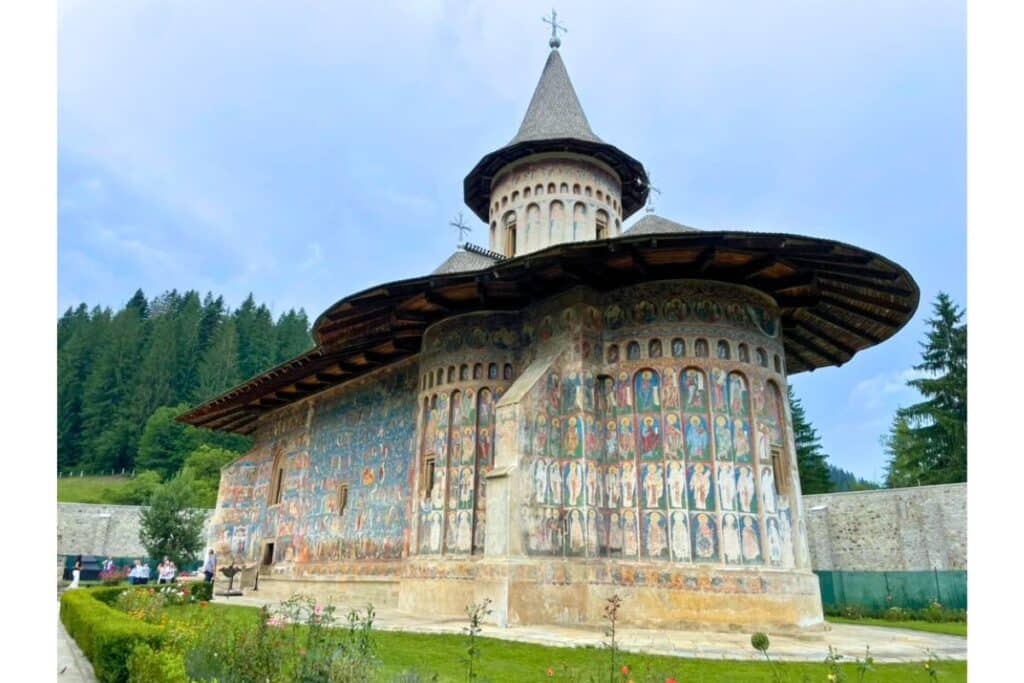
The Voroneț Monastery was built in 1488 by a famous ruler named Stefan Cel Mare, or Stephen the Great, after he won a big battle against the Turks. It is tucked away in a green valley and has become famous for its frescoes that cover the walls, both inside and out.
One of the most famous paintings is “The Last Judgment,” which stretches across an entire wall. It’s like a huge, colorful map of heaven and hell, with angels, devils, and people being judged for their actions. The detail is insane!
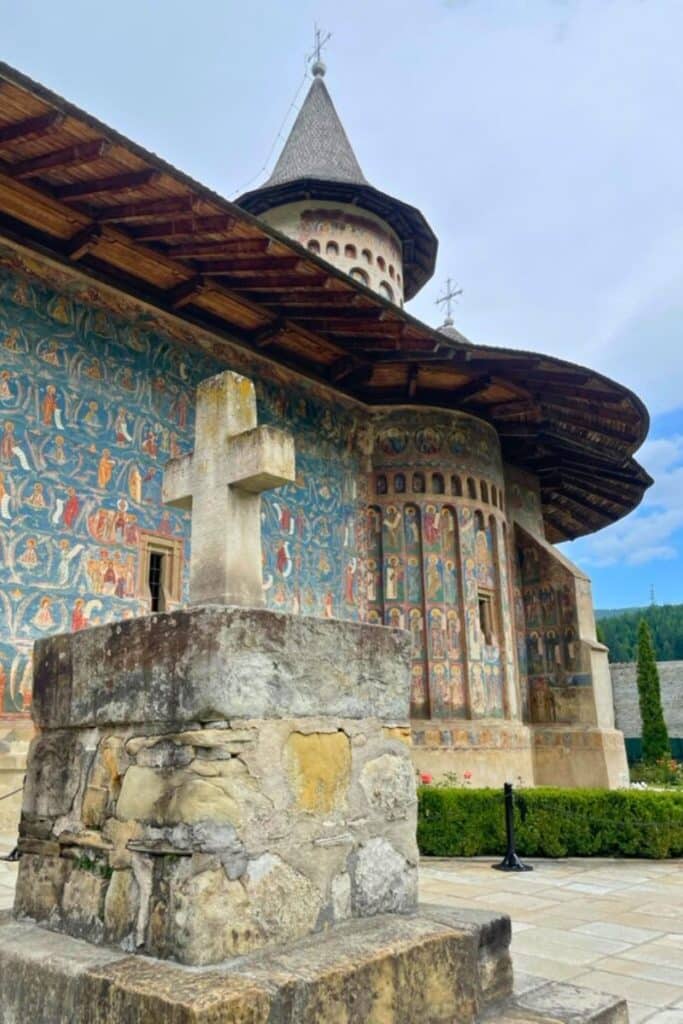
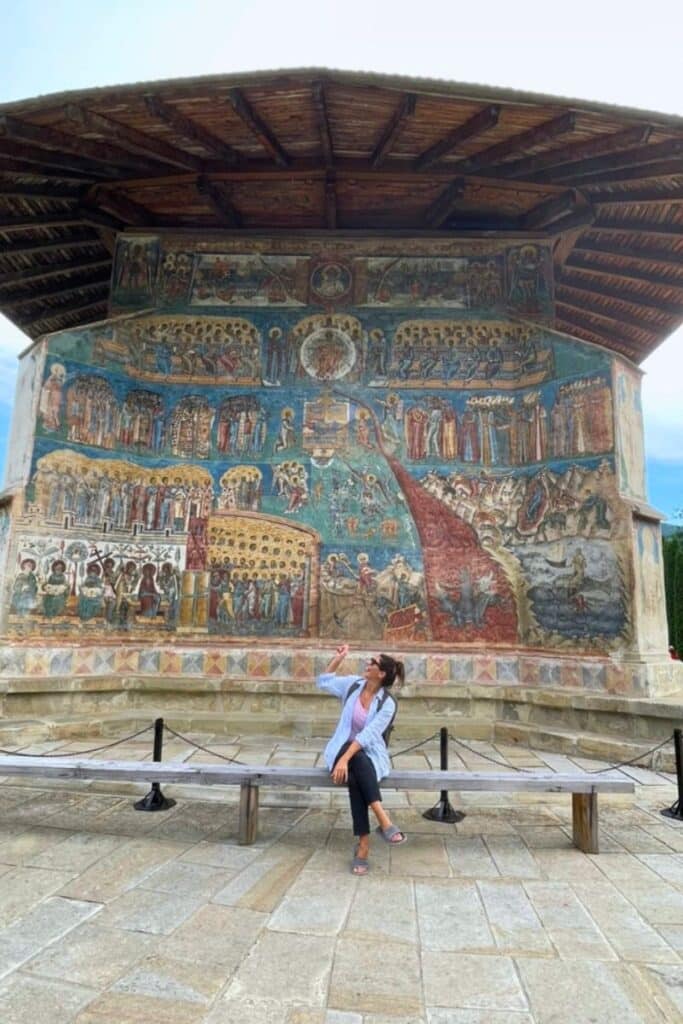
According to my mom and dad, the really cool part is that the monastery’s walls are painted with a special color called Voroneț Blue. This brilliant shade of blue, made from crushed azurite, has stayed vibrant for over 500 years.
Scientists still aren’t entirely sure how the artists made it so durable, but it’s one of the reasons Voroneț is so famous today. I will say, one side is absolutely more bright than the other – mostly due to the weather.
❤️💛💙 ROMANIAN COSTUMES NEAR VORONET: Don’t miss the opportunity to take traditional costume portraits – ODAIA BUNICI Photography Shop. We did it, and it is one of our favorite memories from the trip.
Today, the monastery is cared for by nuns, who keep this historic and artistic gem shining for everyone to see. It’s like a magical blend of art, faith, and a little mystery!
Putna Monastery
📍Location: Google Maps
⏰ Opening Hours: 9 a.m – 7 p.m.
🎟️ Admission: Free
Putna Monastery is a bit out of the way, and it’s not colored on the outside, but it’s famous for being the burial ground of one of our most famous Romanian leaders. So we went – and the energy here is that of importance and calm at the same time.
Built in 1466 by Stephen the Great, one of the country’s greatest rulers, Putna was his very first monastery. He wanted it to be a symbol of faith and a resting place for him and his family.
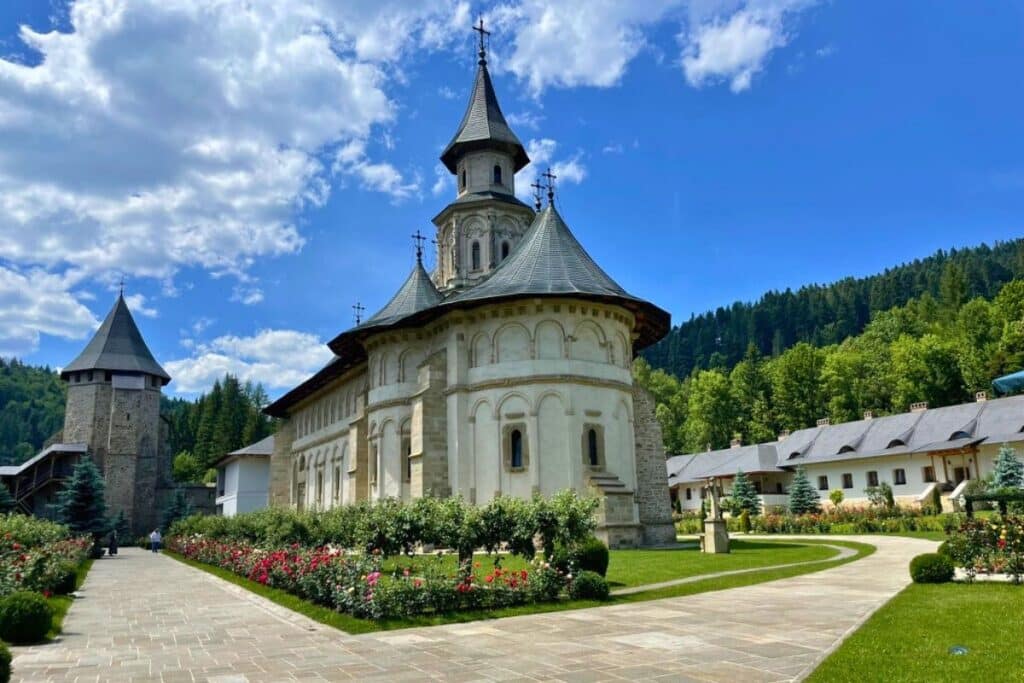
It’s surrounded by thick walls and towers, almost like a fortress, because back then, protecting monasteries from invaders was just as important as praying in them.
Putna isn’t just about its walls, though—it’s about what’s inside. The monastery holds Stephen the Great’s tomb, along with those of his family, making it a pilgrimage site for people who admire his legacy. The church is beautifully decorated with carvings and treasures that reflect his era’s artistry and devotion (and a few skulls on display).
The construction of Putna was so important to Stephen that he personally oversaw much of it. Legend says he shot an arrow into the valley and declared the spot where it landed as the place to build the monastery.
Today, monks take care of Putna. MONKS!! Not nuns like the rest of the monasteries I love. 🫢
Humor Monastery
📍Location: Google Maps
⏰ Opening Hours: 8 a.m – 10 p.m.
🎟️ Admission: 5 lei ($1.25)
Humor Monastery is smaller and cozier than some of the other monasteries, but it’s just as packed with history and beauty (although the paintings are a bit faded).
I thought it was so unassuming, like driving up to the local community church in the small Romanian town where my grandma lives.
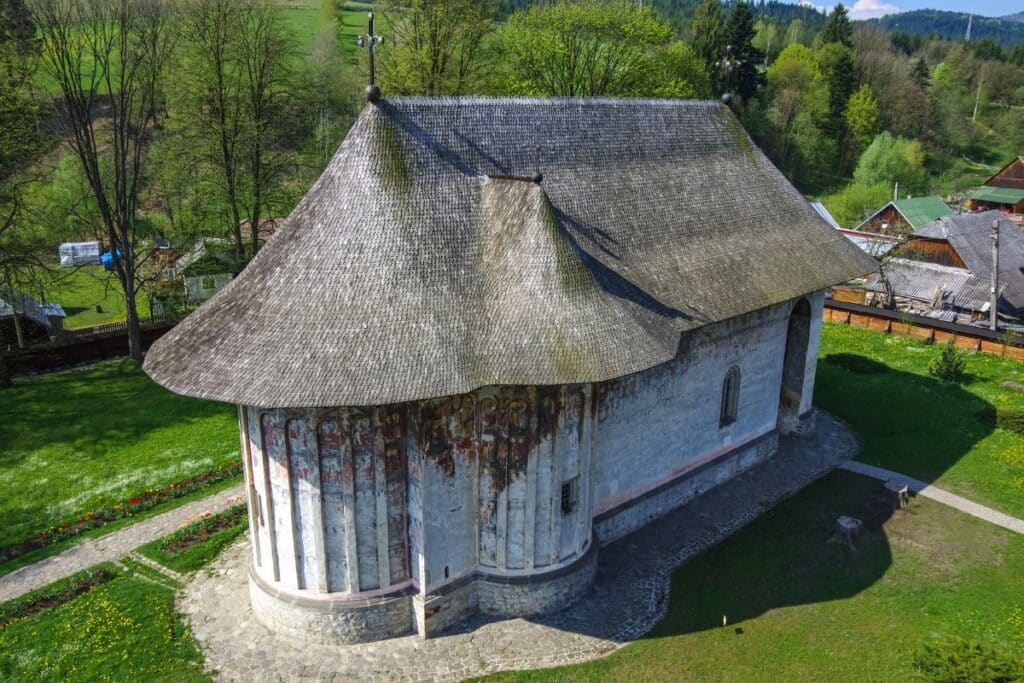
Humor is one of the earliest monasteries to feature paintings on its exterior walls, and it is famous for a rich red pigment that you don’t see at any of the other monasteries in Bucovina.
Today, nuns live here and take care of this historic little gem, sharing its peaceful atmosphere and incredible art with visitors.
What Is The Most Beautiful Monastery in Romania?
My personal favorite painted monastery in Romania is Sucevița, followed closely by Moldovița.
These two have the most prominently preserved exterior paintings, and the best rose gardens in my opinion, and while they look similar in my pictures, they are quite unique and cute in their own way.

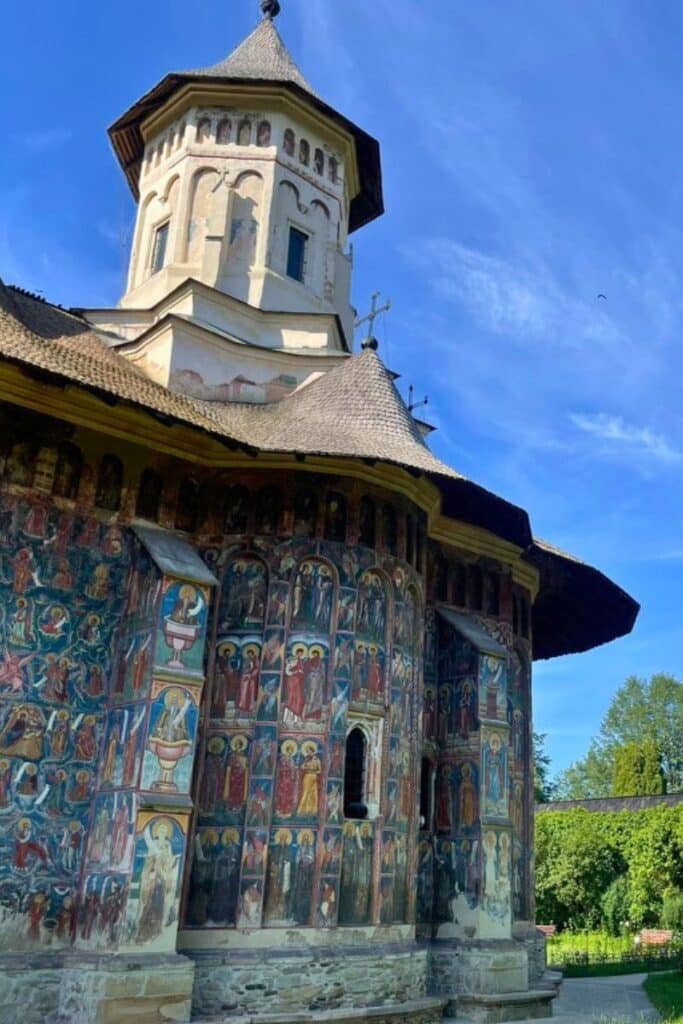
RESPECT THE CHURCH: While inside each monastery, and during the morning and afternoon mass, you should be quiet, and still, and not act like the paparazzi with your phone.
Getting To the Painted Monasteries in Romania
The best way to get to the painted monasteries in Romania is to fly into one of the nearby airports of Iasi or Suceava (both connecting from Bucharest) and then rent a car for a 2-3 day road trip of the monasteries.
There are daily flights from Bucharest to Suceava and to Iasi operated by Tarom, Romania’s National airline. Flight time would be about an hour.
➡️ I use Discover Cars for car rentals in Romania. A regular sedan should be fine, no need for a 4×4 or anything fancy. ⬅️
I recommend spending the first day visiting Sucevita, Moldovita, and Putna. The second day would be spent on Voronet and Humor monasteries. Each monastery is about a 30-minute to an hour distance from each other, but the days get long. If you include a breakfast an lunch stop, 2-3 monasteries a day is plenty!
While you are in the area, there are a few more things to do, as outlined in my 2-week road trip to Bucovina and Maramures.
Where To Stay When Visiting the Painted Monasteries
Towns like Gura Humorului and Suceava are obvious choices near the monasteries, but we chose to stay in a more pretty and authentic little section of Bucovina near Fundul Moldovei.
Where To Stay (2-3 Nights):
📍 La Baciu Colacu – Very authentic mountain cabin with an upscale vibe. My dad was saying only rich Romanians go here, and I think it’s true. That said, it’s so worth it for the beginning of the trip. Every meal is home-cooked, the area is walkable, and the views from the rooms are insane!
Can You Spend The Night in a Painted Monastery?
No. Only the nuns caring for the monasteries, and the monks in the singular case of Putna, can stay.
There are very few exceptions, as my dad was telling me he put up his tent when he visited Putna on the grounds to rest for the night. He had traveled hundreds of miles on his bike in the 1970s to get there, so the monks put him up – can you believe that?!
Final Thoughts: Why Visit The Painted Monasteries in Romania
We visited the painted monasteries of Romania in Bucovina because they are part of our Romanian history and culture.
It’s also a bit of a pilgrimage for Romanians who want to dive deep into their Orthodox religion or see the part of history they only learned about in school – when we bravely fought off the Ottoman Turks in the days of Stefan cel Mare!
All in all, I fell in love with Bucovina and the famous UNESCO World Heritage painted monasteries of Romania.
